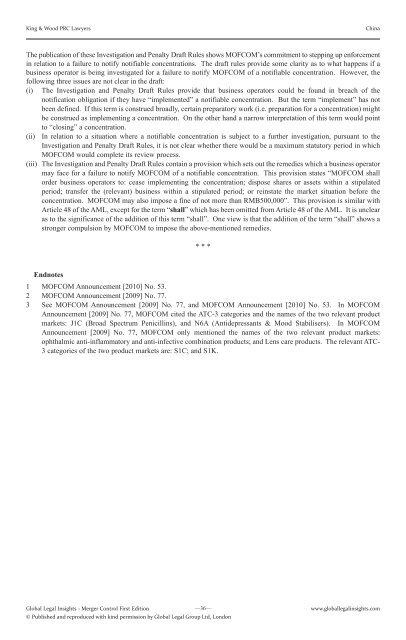Merger Controls First Edition - J Sagar Associates
Merger Controls First Edition - J Sagar Associates
Merger Controls First Edition - J Sagar Associates
Create successful ePaper yourself
Turn your PDF publications into a flip-book with our unique Google optimized e-Paper software.
King & Wood PRC Lawyers China<br />
The publication of these Investigation and Penalty Draft Rules shows MOFCOM’s commitment to stepping up enforcement<br />
in relation to a failure to notify notifiable concentrations. The draft rules provide some clarity as to what happens if a<br />
business operator is being investigated for a failure to notify MOFCOM of a notifiable concentration. However, the<br />
following three issues are not clear in the draft:<br />
(i) The Investigation and Penalty Draft Rules provide that business operators could be found in breach of the<br />
notification obligation if they have “implemented” a notifiable concentration. But the term “implement” has not<br />
been defined. If this term is construed broadly, certain preparatory work (i.e. preparation for a concentration) might<br />
be construed as implementing a concentration. On the other hand a narrow interpretation of this term would point<br />
to “closing” a concentration.<br />
(ii) In relation to a situation where a notifiable concentration is subject to a further investigation, pursuant to the<br />
Investigation and Penalty Draft Rules, it is not clear whether there would be a maximum statutory period in which<br />
MOFCOM would complete its review process.<br />
(iii) The Investigation and Penalty Draft Rules contain a provision which sets out the remedies which a business operator<br />
may face for a failure to notify MOFCOM of a notifiable concentration. This provision states “MOFCOM shall<br />
order business operators to: cease implementing the concentration; dispose shares or assets within a stipulated<br />
period; transfer the (relevant) business within a stipulated period; or reinstate the market situation before the<br />
concentration. MOFCOM may also impose a fine of not more than RMB500,000”. This provision is similar with<br />
Article 48 of the AML, except for the term “shall” which has been omitted from Article 48 of the AML. It is unclear<br />
as to the significance of the addition of this term “shall”. One view is that the addition of the term “shall” shows a<br />
stronger compulsion by MOFCOM to impose the above-mentioned remedies.<br />
* * *<br />
Endnotes<br />
1 MOFCOM Announcement [2010] No. 53.<br />
2 MOFCOM Announcement [2009] No. 77.<br />
3 See MOFCOM Announcement [2009] No. 77, and MOFCOM Announcement [2010] No. 53. In MOFCOM<br />
Announcement [2009] No. 77, MOFCOM cited the ATC-3 categories and the names of the two relevant product<br />
markets: J1C (Broad Spectrum Penicillins), and N6A (Antidepressants & Mood Stabilisers). In MOFCOM<br />
Announcement [2009] No. 77, MOFCOM only mentioned the names of the two relevant product markets:<br />
ophthalmic anti-inflammatory and anti-infective combination products; and Lens care products. The relevant ATC-<br />
3 categories of the two product markets are: S1C; and S1K.<br />
Global Legal Insights <strong>Merger</strong> Control <strong>First</strong> <strong>Edition</strong><br />
—36—<br />
© Published and reproduced with kind permission by Global Legal Group Ltd, London<br />
www.globallegalinsights.com


